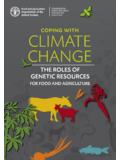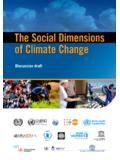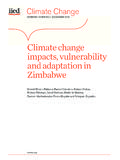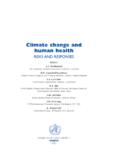Transcription of Agriculture and Climate Change - OECD.org
1 @OECD Agriculture September 2015 Agriculture and Climate Change 1. Climate Change is exacerbating the challenges faced by the Agriculture sector, negatively affecting both crop and livestock systems in most regions. 2. Agriculture is also contributing a significant share of the greenhouse gas (GHG) emissions that are causing Climate Change 17% directly through agricultural activities and an additional 7% to 14% through land use changes. 3. Technical solutions exist and underscore the potential of the Agriculture sector to be part of Climate Change mitigation and adaptation solutions. 4. Without consistent policy signals, autonomous efforts by farmers are unlikely to be sufficient to create a sustainable, productive and resilient Agriculture sector. 5. This note highlights three pillars of reform that can help governments to achieve sustainable productivity growth without sacrificing Climate Change mitigation and adaptation objectives: At the national level, the signals sent by the wider social, economic and environmental policy settings should support the objectives of a sustainable, Climate friendly, resilient and productive Agriculture sector.
2 At the sector level, governments should strengthen consistency and get the incentives right within the overall Agriculture policy set by removing policies which generate unsustainable production systems and exacerbate Climate Change . At the farmer level: emphasis should be on incentives to enhance farmer capacity to adopt practices that contribute to sustainable productivity growth while also responding to Climate Change . This note was prepared ahead of UNFCCC COP21 to provide decision makers with key highlights from OECD analyses on challenges and policy recommendations related to Agriculture and Climate Change in the wider context of sustainable productivity growth. What s the issue? Climate Change is intensifying challenges for the Agriculture sector Climate Change is exacerbating the challenges faced by the Agriculture sector.
3 Climate Change -induced increases in temperatures, rainfall variation and the frequency and intensity of extreme weather events are adding to pressure on the global Agriculture system which is already struggling to respond to rising demands for food and renewable energy. The changing Climate is also contributing to resource problems beyond food security, such as water scarcity, pollution and soil degradation. As resource scarcity and environmental quality problems emerge, so does the urgency of addressing these challenges. Climate Change is expected to negatively affect both crop and livestock production systems in most regions, although some countries may actually benefit from the changing conditions. Overall, productivity levels are expected to be lower than without Climate Change due to changes in temperatures, crop water requirements and water availability and quality.
4 Figure 1 presents projected changes in yields for maize, wheat, and rice in 2050 under a Climate Change scenario (calculated by two different models) as compared to potential 2050 yields under a scenario without Climate Change after 2005. Impacts on agricultural production will vary among regions and will depend not only on the intensity of the changes in temperatures and water but also on how these factors interact. @OECD Agriculture September 2015 Figure 1. Effects of Climate Change on yields are negative in most producing regions (red shades), but some regions may actually benefit (blue shades) Future Climate projections for 2050 based on IPSL model Future Climate projections for 2050 based on Hadley model Maize Wheat Rice Note: Projected changes in yields for maize, wheat, and rice in 2050 under Climate Change as compared with potential 2050 yields if there had been no Change in Climate after 2005 Source: Based on Ignaciuk and Mason-D Croz (2014) Agriculture is also contributing a significant share of the greenhouse gas (GHG) emissions that are causing Climate Change 17% directly through agricultural activities and an additional 7% to 14% through changes in land use.
5 The main direct agricultural GHGs emissions are nitrous oxide emissions from soils, applications of fertilisers, dejections from grazing animals, and methane production by ruminant animals (enteric fermentation) and paddy rice cultivation (Figure 2). Currently accounting for 58% of total anthropogenic nitrous oxide emissions and 47% of total anthropogenic methane emissions, Agriculture is expected to remain the main source of these non-CO2 gases in the coming decades. This trend is particularly concerning given the significantly higher global warming potential of nitrous oxide and methane relative to CO2. In addition, the sector generates emissions indirectly due to changes in land use, including land clearing and deforestation. Figure 2. Agriculture sector is a key source of methane and nitrous oxide emissions, in OECD countries Note: Excluding LULUCF (land use, land use- Change and forestry).
6 Source: OECD (2014), Green Growth Indicators for Agriculture : A Preliminary Assessment, OECD Green Growth Studies, DOI: Ruminants, 37% Manure management, 15% Soil, 46% Rice, 1% Other, 1% @OECD Agriculture September 2015 In OECD countries, the Agriculture sector accounts for 8% of total average GHG emissions, but the sector s contribution varies significantly across As illustrated in Figure 3, the share of Agriculture in GHG emissions ranges from 2% in Japan to 46% in New Zealand. Figure 3. Share of Agriculture in national total GHG emissions differs among OECD countries (2010-12) Note: Excluding LULUCF (land use, land use- Change and forestry). Note: The statistical data for Israel are supplied by and under the responsibility of the relevant Israeli authorities.
7 The use of such data by the OECD is without prejudice to the status of the Golan Heights, East Jerusalem and Israeli settlements in the West Bank under the terms of international law. Source: OECD (2014), Green Growth Indicators for Agriculture : A Preliminary Assessment, DOI: Do technical solutions exist for mitigation and adaptation? Existing technical practices that mitigate GHG emissions underscore the potential of the Agriculture sector to be part of the fight against Climate Change . The overall GHG emission intensity (emissions per unit of production or area) of OECD agricultural producers has declined over the last 20 years. From 1990 to 2010, total gross agricultural GHG emissions in the OECD area decreased, leading to an overall reduction of nearly 44 million tonnes of CO2 equivalent.
8 During the same period, agricultural production volume increased by per annum, resulting in annual reductions of in the emissions intensity of agricultural output. This was achieved by switching to cost-effective practices such as more efficient fertilisation and input uses that reduced nitrous oxide emissions. Productivity growth has also been maintained in the Agriculture sector because farmers have been independently taking measures to adapt to Climate Change . They have begun to adapt farming practices based on their own private cost-benefit calculations, taking into account the additional production risks created by Climate variability as well as the need to achieve higher productivity to improve resource-use efficiency. Many Climate adaptation options that have been adopted to date reflect current best practices and sustainable resource management.
9 Practices such as adopting Climate -smart inputs and shifting to more efficient irrigation methods have helped many farmers to maintain productivity levels and concurrently reduce GHG emission intensity. However, there is still room for further adoption of Climate -friendly and Climate -proof practices. 1 These totals do not include CO2 emissions arising from fuel combustion on-farm, land use changes on-farm, or any emissions that occur off-farm, such as those that arise from the production of inputs, such as feed, energy or fertiliser. 0510152025303540455001002003004005006007 00% Share of Agriculture in total GHGGHG emissions /GDP @OECD Agriculture September 2015 What should policymakers do? Efforts at the national, sector and farm level are needed Without consistent policy signals, farmers may not be able to do enough to create a sustainable, productive and resilient Agriculture sector.
10 Where there are market failures, where private costs are lower than social benefits, farmers will not invest enough in adaptation and mitigation. Moreover, farmers are often faced with conflicting policy signals. Some policies encourage production at the expense of Climate Change objectives, while other measures try to offset these negative effects. Governments need to identify such inconsistencies and develop a coherent set of incentives for achieving sustainable productivity growth with mitigation and adaptation as part of this effort. Achieving this will require involvement of the private sector, communities and governments, with policy solutions tailored to reflect private and social costs and benefits. Some situations will call for national and international cooperation, others for local or regional initiatives.















